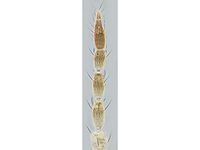Thrips palmi
| Literature database |
|---|
| 185 articles sorted by: |
| • year (descending) |
| • research topics |
| • countries/regions |
| • host plants |
| • list of natural enemies |

Author(s): Laurence Mound, ANIC, CSIRO
Source: PaDIL
Thrips palmi Karny 1925 - (palm thrips)
The thrips is a serious polyphagous pest which is native to Southeast Asia but has spread to various other regions. It now has a world-wide distribution in tropical and subtropical areas. It has spread to Europe repeatedly causing outbreaks in greenhouses, but eradiaction has sofar been always successful. It has become established in several countries of Central and South America and is recorded from Florida since 1990.
It is particularly damaging to vegetables like cucumber, eggplant or green pepper, causing silvery scars on the leaves and fruits or chlorosis. Most importantly, it is a vector of various tospoviruses, like Groundnut bud necrosis virus or Melon yellow spot virus. Dispersal is mainly through infested plants. Control through insecticides has been the standard management approach, but pesticide resistance has become a problem.
| Vernacular names | |
|---|---|
| • Deutsch: | Palmthrips Melonenthrips |
| • English: | palm thrips melon thrips |
| • Español: | trips del melón piojito Amarillo |
| • Français: | thrips du palmier thrips du melon |
The adults are slightly more than 1 mm long and yellowish. The life cycle from egg, through 2 larval stages, to mature adult lasts about 3 weeks. Pupation occurs in the ground. Diagnostic features are listed in the box on the right (below) according to Riley et al. (2011).
| Diagnostic features: | |
|---|---|
| • | colour yellow |
| • | antennae with 7 segments |
| • | elongated anterior setae on pronotum absent |
| • | two pairs of long posteroangular setae |
| • | setae originate within the triangular area of ocelli |
| • | ocelli with red pigment |
Synonyms:
Chloethrips aureus
Thrips gossypicola
Thrips gracilis
Thrips leucadophilus
For details see the respective page in Wikipedia.
- Other images of Thrips palmi (PaDIL and Wikimedia Commons - click to enlarge)




